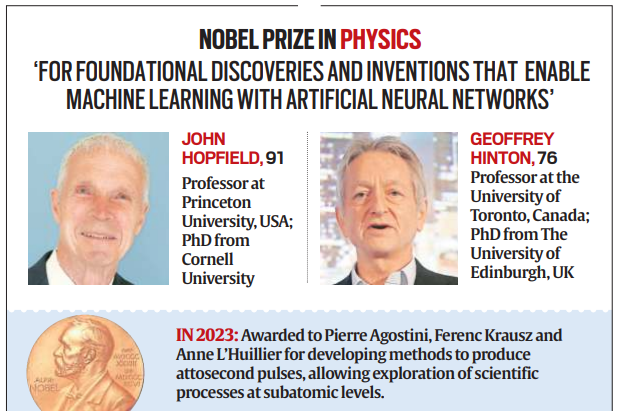AI Pioneers Hopfield and Hinton Awarded Nobel Prize for Revolutionizing Machine Learning with Neural Networks
(Source: Indian Express; Section: Explained; Page: 19)
| Topic: GS3 – Science and Technology |
| Context: |
| The article highlights the groundbreaking contributions of John Hopfield and Geoffrey Hinton in developing neural networks, which have revolutionized artificial intelligence and earned them the Nobel Prize in Physics. |
Analysis of News:
Artificial Intelligence: A Game Changer
- Artificial intelligence (AI) tools have become a key part of modern life, enabling users to access information, create multimedia, and analyze large data sets in ways that were unthinkable just a few years ago.
- AI is transforming the way people work and live, with applications ranging from everyday tasks on computers and phones to complex problem-solving in scientific fields.
Nobel Prize for AI Foundations

- This year’s Nobel Prize in Physics recognized John Hopfield and Geoffrey Hinton for their groundbreaking work in artificial neural networks.
- These scientists, who made major contributions in the 1980s, laid the foundation for today’s AI revolution.
- Their research is only now being fully realized, as the capabilities of machine learning and AI continue to advance rapidly.
Mimicking the Human Brain

- Hopfield’s key contribution was the development of neural networks that mimic the functioning of the human brain.
- His work in the 1980s allowed machines to “remember” and “learn” by building neural networks similar to the nerve cells in the brain.
- This breakthrough helped enable pattern recognition, which powers modern technologies like facial recognition and image enhancement tools.
Deep Learning: A New Era
- Geoffrey Hinton expanded on Hopfield’s work, introducing deep learning techniques. His method, known as backpropagation, allowed neural networks to learn from their mistakes and improve accuracy.
- This innovation led to the development of deep neural networks, which are crucial for today’s AI systems like voice assistants, image recognition, and self-driving cars.
Real-World Impact of AI
- Hinton’s work gained global recognition when his team’s algorithm, AlexNet, demonstrated superior image recognition at the 2012 ImageNet competition.
- This marked a turning point in the AI field, solidifying the potential of deep learning. Today, AI is used across industries, from astronomy to healthcare, for analyzing vast amounts of data and identifying significant patterns.
Legacy of the Pioneers
- Both Hopfield and Hinton have left an indelible mark on AI and computer science.
- While Hopfield’s work drew from his background in physics and biology, Hinton’s deep learning advancements have revolutionized computer science.
- Together, their contributions continue to shape the future of AI, earning them a place among the pioneers of the digital age.
| What is an Artificial Neural Network? |
|
| Practice Question: Discuss the contributions of John Hopfield and Geoffrey Hinton in the development of artificial neural networks and their impact on the evolution of artificial intelligence. How have these advancements transformed modern technologies? (150 words/10 m) |


